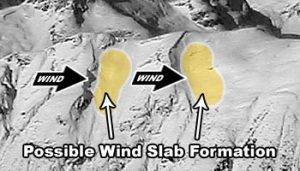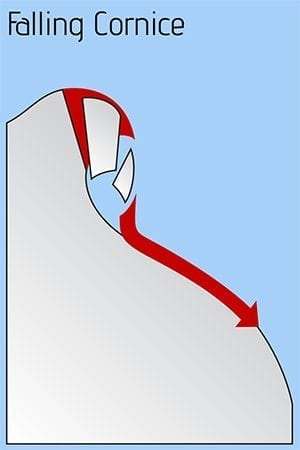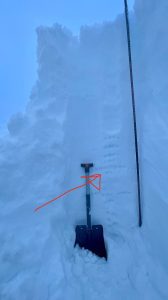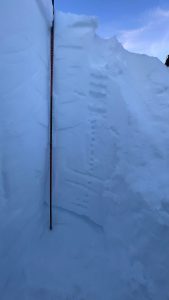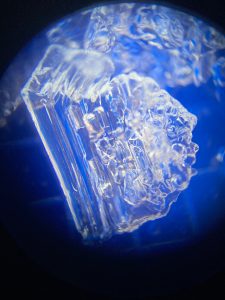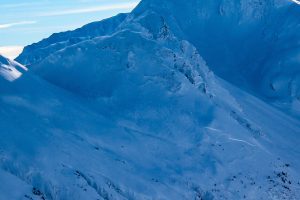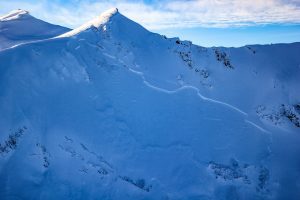Haines Avalanche Center
Above 2,500ftModerate
1,500 to 2,500ftModerate
Below 1,500ftLow
Degrees of Avalanche Danger
Avalanche Problems
Problem 1
The Bottom Line: Overall we are still observing lingering poor structure in the deeper snowpack. Having just dropped down from Considerable danger, we are in the mindset of “scary moderate.” Over the last week, the NW and N winds blew hard, loading up SW through S through E aspects with wind slabs and cross-loading other aspects, gullies, and features. Most alpine areas are going to be a mix of sustrugi, hard slabs / wind board, and slabby powder in protected areas. Variability in these surface wind slabs is high. The most dangerous areas will be wind loaded solar aspects steeper than 32 degrees where you may still find tender slabs resting on weak old snow. Likewise, cross-loaded gullies will have wind slabs and pillows that could take you for a nasty ride. Some nice softer snow remains in the trees.
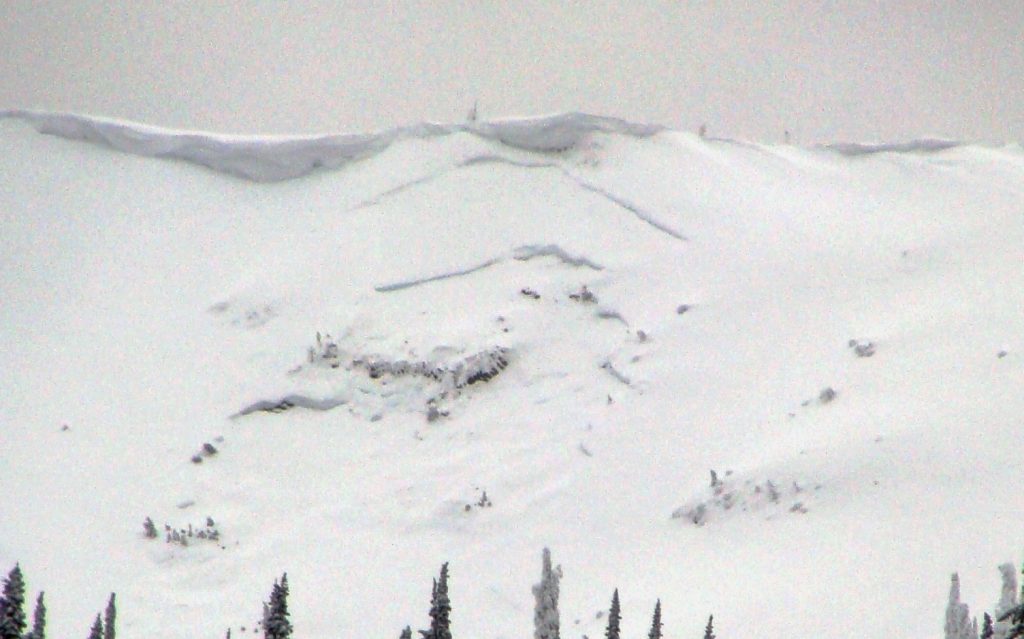
Photo: Example of a wind loaded slope with a wind slab avalanche that stepped down to deeper persistent layers below. This one was probably triggered by cornice fall. Photo from Flathead Avalanche Center.
Wind slabs can be avoided by sticking to sheltered or wind-scoured areas. Also from the wind, cornices will be unsupported, scoured, and weak. Tread carefully around them and limit your exposure to slopes below them. A cornice drop could cause a slide, with potential for a step down.
The severe consequences of our avalanche problems remain, due to deep persistent layers. Be hypersensitive of terrain- it is an active way to manage our exposure to the risk of an unlikely but high-consequence deep slab avalanche.
When on or near avalanche terrain, be diligent on terrain selection, group management, and human factor. Travel one at a time or with enough spacing so that only one person is exposed to an avalanche path at any one time. Be prepared for an avalanche that could step down to deeper instabilities, creating a slide that could break very wide, and take out all the “safe” zones on a slope. Be extra careful not to group up in places that an avalanche can reach.
Likelihood:
- Almost Certain
- Very Likely
- Likely
- Possible
- Unlikely
Size:
- Historic
- Very Large
- Large
- Small
Trend
- Increasing
- Steady
- Decreasing
Problem 2
When seeking out wind protected zones, remember that wind-protected pockets may be harboring weak, buried surface hoar layers. Protected means preserved. These mid-pack layers appear to be what failed in this weeks avalanches observed.
Buried Surface Hoar Layers (These layers have become less reactive in snowpits, but smaller slides could still step down and trigger them):
- Jan 25th melt freeze crust is about 2-3 feet deep (with recent winds and snow, there is a lot of variability on depth of this widespread layer) sitting on top of it are near surface facets, and buried surface hoar from Feb 1-4.
- January 10th surface hoar is now buried about 4 feet deep.
March 2nd: Snowpit at 2700ft on Flower mountain found weakness about 75cm deep, and some healing of deeper weak layers. But we are not confident on how well this pit maps to other areas. The takeaway is that while some healing is happening, it is variable across the landscape.

Likelihood:
- Almost Certain
- Very Likely
- Likely
- Possible
- Unlikely
Size:
- Historic
- Very Large
- Large
- Small
Trend
- Increasing
- Steady
- Decreasing
Problem 3
Cornices have become very large and weak. They are undercut, overhanging, and slowly sagging as they grow. Strong sunshine and increasing winds will put a lot of stress on these dangerous beasts (especially as temperatures rise). Stay way back from any snow ledges or cornices on ridgelines or summits. Some may fall naturally, so do not travel below them. More likely will be human triggering of cornices from above. When a cornice fails, it will break way further back on the ridge than expected and take most of the flat terrain out with it. Any cornice falls are likely to trigger very large and deadly deep-slab avalanches. Consequences are very high right now.
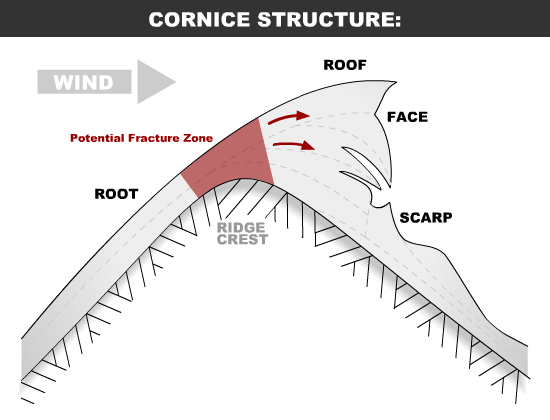
Likelihood:
- Almost Certain
- Very Likely
- Likely
- Possible
- Unlikely
Size:
- Historic
- Very Large
- Large
- Small
Trend
- Increasing
- Steady
- Decreasing
Problem 4
Old Melt Layers and Crusts:
- Dec 31 surface hoar layer is present in the Transitional and Pass zones, about 5 ft deep. This layer has been active in pits, and caused some natural avalanches in early January.
- A buried persistent weak layer about 7+ feet deep (The “Big Warmup” Layer, Formed Nov 17th) is still a concern. Numerous natural avalanches observed 1/27 likely on this layer.
- A wide safety margin is necessary. This setup could produce avalanches that break wider than expected, and are most likely to be triggered from shallow trigger points like rocks or small trees. You could ride the same slope numerous times until that right spot produces a large destructive slide.
“Big Warmup” facet layer in the Transitional Zone at 2500ft on Jan 2 with test results ECTP18 that demonstrated propagation potential on this layer.
Pit at Old Faithful, 2500’, East aspect on Jan 12. A 5″ thick layer of facets down 170cm. Also, observation noted faceted surface conditions.
Depth Hoar at the Ground (Above 3,000′):
- October snow followed by long cold snaps created depth hoar at the ground in most areas.
- You are most likely to human-trigger this layer from shallow spots around rocks, or trees, or have a surface avalanche step down to the ground on this layer. Any slides that break to the ground are likely to be deadly.
Photos shows 6-9mm advanced depth hoar at the ground down 180cm with ECTP 25 down 80cm on facets below a crust in the Haines Pass Zone at 4,000ft on a NE-aspect.
Likelihood:
- Almost Certain
- Very Likely
- Likely
- Possible
- Unlikely
Size:
- Historic
- Very Large
- Large
- Small
Trend
- Increasing
- Steady
- Decreasing
Avalanche Activity
March 4-5: Human triggered wind slab D1/D2 at 5-mile creek Chilkat Pass, 2200ft, W aspect
D2-R4 hard slab: Mid-slope propagation, E aspect, in steep wind loaded area, unsupported slope.
D2-R4: New Faithful, W aspect, high alpine
March 2: Small natural soft slabs were observed in steep trees in the Lutak zone. This kind of small to large natural activity is likely widespread in the Lutak zone.
Feb 19-23: 6 different observations of natural avalanches in the transitional zone and in the Chilkat range. The natural D2 slides were on all aspects, a few on lower angle, all running on a mid-snow pack layer, and a majority with widespread propagation.
A larger, D3-R4 natural avalanche was observed near Four Winds on a S, SW aspect, down 60-120cm, it looked like a loose wet slide that maybe stepped down to a lower layer. Widespread propagation.
Feb 9: Glide cracks ~3000-3400′ in the transitional zone on N, NE aspects. Also notable was observation of reloading of bed surfaces on previous slides.
Jan 28: Two D2’s in the Lutak Zone, Glory Hole NW-aspect around 3,200 ft
Jan 25-29th: Multiple wide propagating natural slides released Jan 25-29th
Weather
Forecast:
Continued sunny and breezy with moderate NW winds and cold temperatures, and strong solar radiation. There are hints that the pattern might change mid-next week, but until then we are under strong high pressure.
Recent Weather Summary:
- March 4-7 strong NW / N outflow event with cooling temps.
- March 1st brought a strong and cold storm, with 10-15″ of new snow inland, and 30″+ in the Lutak zone.
- Late Feb 20-Feb 23 a cold high pressure system with moderate to strong N, NW winds
- Feb 19-Feb 20- warmer, solar effect on south aspects, valley fog on the 19th at ~1500-2000 ft.
- Feb 12 freezing levels 1250ft
- Incremental snow (more in Lutak zone) since Feb 5th, periods of moderate S/SE winds
- Feb 1-4 Near surface facets on top of crust from Jan 25 warm-up
- Jan 17-26 brought around 5″ of precip (3-5feet of new snow above 3000ft), strong SE winds, and a noticeable warmup
- Surface Hoar and Near Surface Facet growth Jan 8-10
- A strong front brought 24-30″ of snow above 2000ft on Jan 2nd.
- There was widespread Surface Hoar growth on Dec 31st.
- Complete Season Histories: Transitional Zone Lutak Zone
| Snow Depth | Last 24-hr Snow/SWE | Last 3-days Snow/SWE | Today’s Freezing Level | Today’s Winds | Next 24-hr Snow/SWE | |
| Mount Ripinsky @ 2,500′ | 156″ | 0″ / 0.00 | 0″ / 0.00 | 0′ | mod, NW | 0″ / 0.00″ |
| Flower Mountain @ 2,500′ | 62″ | 0″ / 0.00 | 0″ / 0.00 | 0′ | mod, NW | 0″ / 0.00″ |
| Chilkat Pass @ 3,100ft | 40″ | 0″ / 0.00 | 0″ / 0.00 | 0′ | mod, NW | 0″ / 0.00″ |
Additional Information
WEAR A HELMET! Be careful of rocks and hidden hazards. Be prepared for crevasses when on a glacier.
Are your riding companions trained and practiced in avalanche rescue? Everyone in your group needs to have a beacon, shovel, and probe, and know how to use them. Our mountains have very limited cell coverage, carry an emergency communication device and enough gear to spend the night.
Avalanche Canada’s Daily Process Flow – Utilize this everyday you go out in the mountains.
Announcements
Click the +Full Forecast link below for each zone to read more. If you see any recent natural avalanche activity, or signs of instability please submit an observation.
